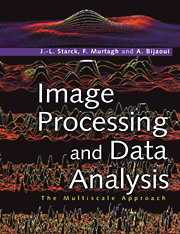Book contents
- Frontmatter
- Contents
- Preface
- 1 The wavelet transform
- 2 Multiresolution support and filtering
- 3 Deconvolution
- 4 1D signals and Euclidean data analysis
- 5 Geometric registration
- 6 Disparity analysis in remote sensing
- 7 Image compression
- 8 Object detection and point clustering
- 9 Multiscale vision models
- APPENDIX A Variance stabilization
- APPENDIX B Software information
- APPENDIX C Acronyms
- Bibliography
- Index
5 - Geometric registration
Published online by Cambridge University Press: 30 October 2009
- Frontmatter
- Contents
- Preface
- 1 The wavelet transform
- 2 Multiresolution support and filtering
- 3 Deconvolution
- 4 1D signals and Euclidean data analysis
- 5 Geometric registration
- 6 Disparity analysis in remote sensing
- 7 Image compression
- 8 Object detection and point clustering
- 9 Multiscale vision models
- APPENDIX A Variance stabilization
- APPENDIX B Software information
- APPENDIX C Acronyms
- Bibliography
- Index
Summary
Image registration of remotely sensed data is a procedure that determines the best spatial fit between two or more images that overlap the same scene, acquired at the same time or at different times, by identical or different sensors. This is an important step, as it is frequently necessary to compare data taken at different times on a point-to-point basis, for many applications such as the study of temporal changes for example. Therefore we need to obtain a new dataset in such a way that its image under an appropriate transform is registered, geometrically, with previous datasets.
The inventory of natural resources and the management of the environment requires appropriate and complex perception of the objects to be studied. Often a multiresolution approach is essential for the identification of the phenomena studied, as well as for the understanding of the dynamical processes underlying them. In this case, the processing of data taken with different ground resolutions by different or identical sensors is necessary.
Another important situation where the need for different images acquired with a different ground resolution sensor arises is when the generalization to larger surface areas of an identification or an interpretation model, based on small areas, is required (Achard and Blasco, 1990). This is the case for studies on a continental scale. Examples of this application can be found in Justice and Hiernaux (1986), Hiernaux and Justice (1986) and Prince, Tucker and Justice (1986). Therefore, the data must be geometrically registered with the best possible accuracy.
- Type
- Chapter
- Information
- Image Processing and Data AnalysisThe Multiscale Approach, pp. 152 - 184Publisher: Cambridge University PressPrint publication year: 1998
- 1
- Cited by



